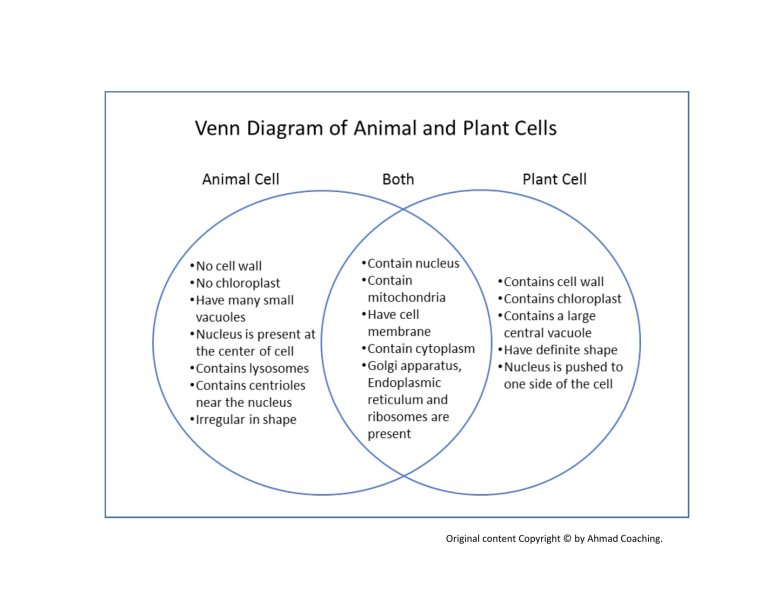Cell biology, akin to the enigmatic tapestry of life itself, unfurls the intricate patterns that define living organisms. When we delve into the microscopic world of cells, we encounter two distinct yet interconnected realms: animal cells and plant cells. To appreciate the multifaceted nature of these cells, a Venn diagram serves as a metaphorical lens—illuminating their shared features while simultaneously casting light on their unique attributes.
At the center of this cellular discourse lies the paradox of similarity amidst diversity. Picture two vibrant circles on a canvas, their boundaries merging where they share commonalities, while the surrounding areas resonate with the distinctive traits that characterize each type. This visual representation is not merely a tool; it is an artistic narrative of how life is structured at a cellular level.
First, let us wander into the realm of animal cells. These cells are comparable to the dynamic inhabitants of a bustling metropolis. They exhibit a flexible shape, absence of a rigid cell wall, and a plethora of organelles each playing a crucial role in cellular operations. The nucleus, often regarded as the brain, houses genetic material that orchestrates the symphony of life through its DNA. Mitochondria, likened to power plants, generate the energy necessary for cellular activities. Ribosomes, the diligent workers, concoct proteins that are fundamental to bodily functions. This well-coordinated environment promotes mobility and responsiveness within their surroundings.
In stark contrast, plant cells resemble a robust fortress, guarded by a sturdy cell wall that bestows rigidity and protection. This wall sets them apart, granting them a fixed position in their environment—a significant advantage for their sedentary lifestyle. The presence of chloroplasts, often depicted as the green architects of photosynthesis, is where the magic occurs. Through sunlight, water, and carbon dioxide, these organelles convert radiant energy into nourishment, fostering growth and vitality. Their large central vacuole, akin to a reservoir, stores essential substances and maintains turgor pressure, enabling rigidity and structural integrity. Such traits highlight the remarkable adaptability of plant cells to their unique ecological niche.
As we navigate through the diagram, we discover intriguing intersections where the two domains converge. Both animal and plant cells possess a plasma membrane, functioning as a selective barrier, akin to the security of a building. This membrane regulates the passage of materials—nutrients, waste, and signaling molecules—into and out of the cell, essential for both survival and cellular homeostasis.
Furthermore, both cell types engage in the fundamental process of cellular respiration, albeit using different starting materials. Animal cells depend on glucose derived from consumed food, while plant cells often utilize the energy produced through photosynthesis. This dynamic reflects the interdependence of living organisms—plants provide oxygen and organic compounds necessary for animal life, while animals produce carbon dioxide, a vital component for photosynthesis. In this way, the cycle of life perpetuates, adding layers of complexity to the story of energy flow in ecosystems.
Another shared element is the presence of endoplasmic reticulum (ER), a veritable factory floor. Smooth ER is involved in lipid synthesis and detoxification, whereas rough ER, studded with ribosomes, specializes in protein production. This shared architecture enhances the efficiency of both cell types, enabling them to meet their specific requirements in diverse environments.
However, despite these common threads, divergence persists within the Venn diagram’s circles. For instance, animal cells contain lysosomes—organelles akin to the recycling centers of a city, responsible for digesting waste materials and worn-out organelles. Plant cells, on the other hand, orchestrate a different strategy via autophagy, relying on their larger vacuoles for storage and waste management, highlighting their strategic adaptations to fixed locations.
Moreover, the replication of cells varies significantly across these two kingdoms. In animals, cell division occurs through a process known as mitosis, ensuring genetic material is evenly distributed. Conversely, plants undergo a somewhat more elaborate mechanism called cytokinesis, whereby a cell plate forms to separate the two daughter cells, a poignant metaphor for regeneration and continuity of life.
Ultimately, the Venn diagram not only elucidates the distinct characteristics of plant and animal cells but underscores the wondrous interplay of life forms. As we draw threads of connection between these sorrying beings, we recognize the synergy that sustains ecosystems—a reflection of the interwoven stories of both flora and fauna.
By understanding the subtleties illustrated within this diagram, we gain insights that extend beyond the realm of botany and zoology. The principles of cell biology resonate with themes of cooperation, complexity, and evolution, echoing through the corridors of time as life adapts and survives in an ever-changing world. As we continue to explore this microscopic universe, it becomes evident that the distinctions and similarities between plant and animal cells narrate a larger tale of resilience, connection, and the relentless pursuit of life.
In conclusion, the animal vs. plant cell Venn diagram serves as more than just a scientific illustration; it invites contemplation—prompting us to marvel at the intricacies of life, the various forms it takes, and how the smallest components serve the grand narrative of existence. Each cell, whether animal or plant, plays a mesmerizing role in the overall symphony of life, reminding us of the beauty woven within the microscopic and the spectacular.
